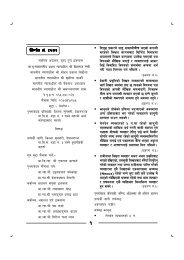The Nepali Judiciary - Supreme Court Of Nepal
The Nepali Judiciary - Supreme Court Of Nepal
The Nepali Judiciary - Supreme Court Of Nepal
You also want an ePaper? Increase the reach of your titles
YUMPU automatically turns print PDFs into web optimized ePapers that Google loves.
During the Plan period, although satisfactory achievements have not been achieved in the<br />
Appellate <strong>Court</strong>s, there has been a reduction of responsibility by 0.8% each year during the Plan<br />
period. Disposal of cases in the District <strong>Court</strong>s have not been uniform and there has been increase<br />
in the backlog of cases. With regards to other courts and tribunals and in comparison to<br />
registration of new cases in the first and second year there has been a decrease in the disposal of<br />
cases but disposal of cases during the third and fourth year has been satisfactory. Although the<br />
objective of all the courts and tribunals was to reduce the number of cases exceeding two years to<br />
zero could not be achieved it can be observed that from among the total number of cases for the<br />
first year 19.44% of cases exceeded two years wherein the said number was reduced to 16.17% in<br />
the fourth year and as such there has been some reduction in the cases exceeding two years.<br />
<strong>The</strong> Plan had envisaged disposing petitions made for execution of judgment within 6 months and<br />
provided petitions could not be disposed within the prescribed period, the Plan had envisaged that<br />
disposal of such petitions would not exceed one year and likewise the Plan had envisaged to<br />
dispose 75% of the pending petitions at the rate of 15% each year. During the Plan period,<br />
petitions regarding execution of decisions were nil in five District <strong>Court</strong>s whereas there were no<br />
petitions regarding execution of decisions that exceeded one year in 17 courts. Although the<br />
expected objective pursuant to the Plan was deemed to have been achieved, expected results<br />
were not able to be achieved in District <strong>Court</strong>s that had excessive work load.<br />
Under the supervision and monitoring function, the honorable justices of the <strong>Supreme</strong> <strong>Court</strong> vested<br />
with the responsibility of carrying out supervision and monitoring of the Appellate <strong>Court</strong> and its<br />
subordinate bodies. Other than in the second year, monitoring of majority of the courts has been<br />
carried in other years. Likewise, in the area of court management, various studies and research<br />
have been conducted.<br />
Likewise, with regards to streamlining and strengthening the management capacity of the judiciary<br />
which was one of the strategic interventions under the first Plan, a <strong>Court</strong> Organization and<br />
Management Committee was constituted for the purpose of providing recommendations deemed<br />
necessary. Pursuant to the recommendation made by the Committee, many of the posts have<br />
been approved and fulfilled whereas some of the posts are in the process of being approved. With<br />
regards to judicial autonomy, a separate Act regarding the terms of service for employees of the<br />
judicial service has been drafted and submitted to the concerned authority. Likewise, a committee<br />
on Financial and Judicial Autonomy was constituted with the purpose of increasing the<br />
disbursement of budget and acquiring financial autonomy with regards to distribution and spending<br />
of budget. <strong>The</strong> Committee had recommended that financial and administration autonomy of the<br />
judiciary should be prescribed in the Constitution. Similarly, a committee had been constituted with<br />
regards to acquiring autonomy in the area of donor assistance, wherein the said committee had<br />
recommended for independent dealings with the donor communities and had also recommended<br />
for acquiring assistance deemed necessary. A permanent committee has been established to<br />
manage the assistance to be received from the donor community and in this regard a Financial<br />
Management Committee has also been established.<br />
Another strategic intervention under the first Plan was to develop infrastructure and logistical<br />
support. For this purpose a Physical Infrastructure and Logistical Committee was constituted,<br />
wherein the said committee had classified various courts under different categories and pursuant<br />
to the categorization, the committee had determined standards for procurement of land and<br />
buildings deemed necessary. Procurement of land and construction of buildings are being followed<br />
pursuant to the recommendation made by the committee. During the Plan period, commendable<br />
iii




![lg0f{o g+=&(&# g]=sf=k= @)^% ;af]{Rr cbfnt ljz]if Ohnf; ;DdfggLo k ...](https://img.yumpu.com/10045627/1/190x245/lg0fo-g-gsfk-afrr-cbfnt-ljzif-ohnf-ddfgglo-k-.jpg?quality=85)
![lg0f{o g+=&(@% g]=sf=k= @)^% ;jf]{Rr cbfnt, ljz]if Ohnf; dfggLo ...](https://img.yumpu.com/6479513/1/190x245/lg0fo-g-gsfk-jfrr-cbfnt-ljzif-ohnf-dfgglo-.jpg?quality=85)

![lgj]b s ljkIfL - Supreme Court Of Nepal](https://img.yumpu.com/5482729/1/190x245/lgjb-s-ljkifl-supreme-court-of-nepal.jpg?quality=85)